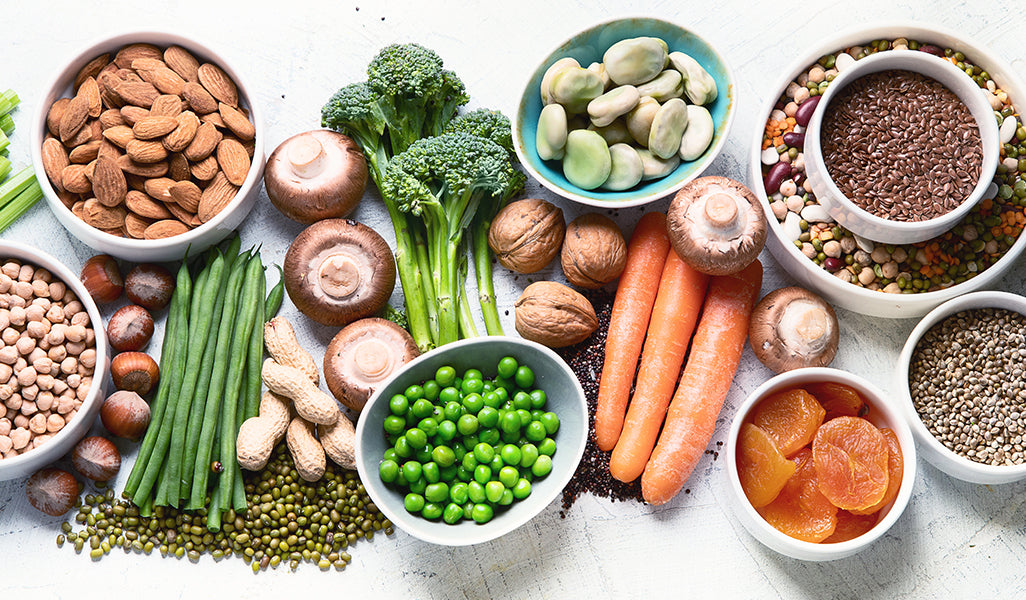
The Advantages and Benefits of Using Plant-Based Protein Powder
The Plant-Based Protein category has been gaining heavy traction across numerous forums and is also the main subject of countless clinical studies that link the benefits over your standard whey protein.
While there has been much debate over this controversial subject, one question stands alone when reviewing information…
Is Plant-Based Protein better than other Whey Protein sources?
It’s important to understand that some answers may be subject to heavy bias and might be lacking enough sufficient evidence to make an educated conclusion.
But this article isn’t about that specific topic.
Instead, this piece will cover the key features that make Plant-Based Protein a great commodity for your everyday nutritional needs.
Let’s get started.
Understanding Protein
Before we dive deeper into the Plant-Based Protein benefits and history, let’s take an in-depth look at what exactly protein is and how protein powder has revolutionized the dietary market.
Protein is one of three macronutrient profiles which are the main nutrients that make up a generalized diet. As you may have commonly heard the phrase, ‘macronutrient calculation’, which consists of measurement for your diet broken down into; Protein, Carbohydrates, and Fats.
Protein is also the main contributor toward building muscle mass and can be found in most food sources, most notably in meat and other animal-based food sources. [1]
Common and essential amino acids also help play a strong role in protein synthesis and the creation of protein molecules that are found within these food sources. [2] This process is a two-step factor that allows for transcription and translation to bond the amino acids which form the polypeptide chain and once synthesized, will become a finished protein. [3]
Protein is also readily available and can be found in natural sources that you might not expect. For example, Plant-Based sources have become a highly touted way of protein consumption with the main difference that sits between animal-based being the amino acid profile. Complete and incomplete protein can also be found in the following plant-based foods at a high amount:

- Almonds
- Chickpeas
- Quinoa
- Lentils
- Hempseed
- Spirulina
- Ezekiel Bread
- Chia Seeds
- Tofu
Plant-Based Protein food sources are a great way to help with digestive balance as they contain healthy amounts of fiber which can normalize bowel movements and have shown to reduce the risk of gut inflammation. [4]
A recent controlled study also shows that during a 16-week randomized clinical trial, subjects who consumed plant-based nutrients and protein saw a decrease in overall fat mass and a decrease in BMI. [5,6,7]
Protein has evolved rather quickly as the rate of consumption can be harder to achieve with direct food sources. Enter, protein powder.
Protein Powder was introduced as a quick and efficient way to improve overall protein intake without having to consume actual food sources that may be difficult to achieve without increasing total volume to hit a specific goal. The most common types of protein powder that you might find yourself seeing in local retail stores are:
- Whey Protein
- Concentrate
- Isolate
- Hydrolysate
- Whey Protein Caseinate
- Beef Protein
- Egg or Egg White Protein
- Plant Protein
While there are many different types of protein powders on the market, the main goal for the introduction of consuming a powder over food sources is for the sheer fact of convenience. With protein powder, you can allow yourself to control the grams per serving to manipulate your diet by hitting targeted goals for a meal or for daily nutritional value.
Of this compiled list, one common type of protein powder stands out for being highly regarded for overall nutritional value and benefits that coincide with consuming this over the others. This protein powder is, Plant-Based.
What is Plant-Based Protein Powder?
Plant-Based protein powder is a highly popular dietary source that consists of ditching animal-based sources for plant-based foods. Acting on the same consensus of protein powders in general, plant-based takes an alternative approach towards introducing different sources for overall health support with the shared benefits that come along with using these specific sources.
Out of the many health benefits, a recent 2016 study at the Academy of Nutrition and Dietetics, confirmed that users who consumed more plant-based nutrients actually had reduced risks of chronic health issues and diseases including; [8,9]
- Ischemic Heart Disease
- Type 2 Diabetes
- Hypertension
- Cancer
- Obesity
These plant-based nutrients have also been proven to be more appropriate for all individuals including athletes, children, seniors, and have even been shown to be useful to females who are pregnant. [10]
As you can see, there are many benefits of Plant-Based protein. By combining the beneficial sources into a well-balanced powder form, you can achieve accurate protein consumption with all of the key attributes of plant-based nutrients.
Nutrex Research Plant Protein was recently awarded the #1 spot at PricePlow for Best Vegan Protein of 2019
What’s Inside Plant-Based Protein Powder?
With the ever-growing sources to combine for a complete plant-based protein formulation, there are many different ingredients you may have seen on the back of supplement labels when you visit your local GNC and Vitamin Shoppe.
There are many notable sources that can be formed into complete proteins such as:
- Pea Protein
- Sacha Inchi
- Sunflower Seed
- Pumpkin Seed
- Hemp Protein
- Soy
- Chia
- Brown Rice Protein
- Yellow Pea Protein
Pea Protein
Pea Protein is a high protein source extracted from yellow peas and contains all essential amino acids that would come from a plant-based substitute in which your body cannot naturally produce. This source is lower in comparison to the characteristics of what you would find with a soy isolate. Overall, this is a great utilization for a substitute over animal-based protein. [11,12]
Sacha Inchi
Sacha Inchi shook the wellness industry as a whole with the hype surrounding that it was the next big Superfood to grace plant-based sources. These seeds have a comparable visual to a dark roasted peanut even though they are in fact in the seeds category. What makes Sacha Inchi special is the incredible health benefits that are linked to this, including:
- Weight loss
- Contain healthy fats and omegas
- They are a complete protein
- Links to overall joint and bone health
- The healthy omega-3’s help with skin and hair benefits
Sunflower Seed Protein
The Sunflower Seed actually contains a hefty amount of protein and is most commonly used within food preparation and cooking. Sunflower Seed protein also has numerous health benefits and is loaded with Vitamin E. Some of these benefits consist of: [13,14,15,16]
- Anti-Inflammation
- Lowers Cholesterol
- Reduces Risk of Heart Attack
Pumpkin Seed Protein
While the pumpkin seed protein might not be complete, it can be combined with multiple sources to make up for this. Pumpkin seed protein is also very high in protein content and can be utilized as an excellent source for nutrients and added benefits. Some of these special benefits include:
- Antioxidants to Reduce Inflammation [17]
- Reduced Risk of Certain Cancers [18]
- Improved Urinary Tract Disorder [19]
Hemp Protein
Hemp, a strain of the popular Sativa plant, is on record to be one of the fastest-growing plants and has been widely used as a complete protein source as it contains all nine essential amino acids that the body needs.
Soy
Soy protein is derived from soybeans that are also a complete protein source with exponential health benefits. [20] According to a study on the consumption of soy protein over animal-based protein, total cholesterol was actually shown to decrease during these controlled environments over time. [21] Soy can be used as a single source or can be combined with other plant-based ingredients for a great protein-packed product.
There has been some controversy surrounding the overuse of soy and consumption from males as it increases overall estrogen levels. While this has been a small headline in recent news, it should be well-noted that it’s actually been shown by some experts to be great for additional health effects.
Chia
Chia seeds are a well-known ‘superfood’ with great protein content (depending on the total volume) and have been used for quite some time. Chia seeds are also a complete protein and have been proven to be a great addition to any plant-based protein formula or matrix.
Brown Rice Protein
Widely regarded as one of the best types of protein powder, brown rice may not be considered a complete protein, but it is more well-known to be involved with a high-profile blend of other plant-based sources for a balanced concoction.
Yellow Pea Protein
Yellow pea protein is often overlooked in certain areas but has been linked to many health factors and benefits ranging from overall heart and kidney health. This is also a complete protein that contains all essential amino acids needed.
Some of these might have you thinking, “Wow, this must taste terrible when mixed up.”
Well, you might actually be correct on this. Many different plant-based sources aren’t necessarily going to taste ‘nice’. On the contrary, you may have already tried a plant-based protein before and couldn’t wait to rinse your mouth out with water.
Countering the dreaded taste value can often be hard to mask without loading it up with artificial sweeteners such as sucralose.
So, where does this leave the ‘All-Natural’, approach with plant-based protein powders?

Industry Leading Gourmet Taste Plant Protein
Nutrex Research Plant Protein combines an ingredient matrix of the highest quality plant-based ingredients such as:
- Yellow Pea Protein
- Brown Rice Protein
- Silk Protein
- Pumpkin Seed Protein
- Sunflower Seed Protein
This specific vegan protein blend brings you a high protein experience per serving at over 20g with low fat and minimal carbohydrates so you can diet properly.
But that’s not what you’re looking for…
“So, does it taste good?!”
If you haven’t tried the all-new, industry-leading Plant Protein by Nutrex Research, you are going to be shocked by how amazing the flavors are without the dreaded ‘grainy’ or ‘sand-like’ textures that make it feel like you’re chugging down dirt from your backyard sandbox.
In fact, Nutrex Research spent countless hours researching multiple different avenues to cross before heading into the formulation room to bring you the best tasting Plant Protein you’ve ever tried.
The reviews are real. By ditching the artificial sweetener route, Nutrex keeps things all-natural for this Plant Protein which is why this is one-of-a-kind. By using Monk Fruit Extract and a Gum Blend (Guar Gum, Xanthan Gum) for mixability and thickening agents, the natural specifics stay in-tact while bringing you an extraordinary tasting experience with every sip.
Final Thoughts
With plant-based protein products leading the charge in the chase to be more health-conscious while searching for the best dietary needs, it’s important to remember the advantages of consuming these plant-based sources and what they are being formulated for.
As the industry continues to evolve, plant proteins have generally stayed neutral with flavoring. Albeit to keep a true-to-word, all-natural compliancy for label purposes. You can consider the game changed with a full understanding of the complete protein sources that make up certain products.
To avoid wasting your time in lines at a retail store or burning unnecessary holes in your pockets, make the smart move and consider the switch to Nutrex Research Plant Protein today.
References
2. Semin Cell Dev Biol. 2005 Feb;16(1):21-7. Epub 2004 Dec 10 https://www.ncbi.nlm.nih.gov/pubmed/15659336
3. Semin Cell Dev Biol. 2005 Feb;16(1):21-7. Epub 2004 Dec 10 https://www.ncbi.nlm.nih.gov/pubmed/15659336
4. Curr Opin Gastroenterol. Author manuscript; available in PMC 2018 Nov 1. https://www.ncbi.nlm.nih.gov/pmc/articles/PMC6005665/
5. Nutr Diabetes. 2018; 8: 58. Published online 2018 Nov 2. doi: 10.1038/s41387-018-0067-4 https://www.ncbi.nlm.nih.gov/pmc/articles/PMC6221888/
6. Nutr Diabetes. 2018; 8: 58. Published online 2018 Nov 2. doi: 10.1038/s41387-018-0067-4 https://www.ncbi.nlm.nih.gov/pmc/articles/PMC6221888/
7. Nutr Diabetes. 2018; 8: 58. Published online 2018 Nov 2. doi: 10.1038/s41387-018-0067-4 https://www.ncbi.nlm.nih.gov/pmc/articles/PMC6221888/
8. J Acad Nutr Diet. 2016 Dec;116(12):1970-1980. doi: 10.1016/j.jand.2016.09.025. https://www.ncbi.nlm.nih.gov/pubmed/27886704
9. J Acad Nutr Diet. 2016 Dec;116(12):1970-1980. doi: 10.1016/j.jand.2016.09.025. https://www.ncbi.nlm.nih.gov/pubmed/27886704
10. J Am Diet Assoc. 2009 Jul;109(7):1266-82. https://www.ncbi.nlm.nih.gov/pubmed/19562864
11. Nahrung. 2001 Oct;45(6):399-401. Isolation and study of the functional properties of pea proteins https://www.ncbi.nlm.nih.gov/pubmed/11712241
12. Nahrung. 2001 Oct;45(6):399-401. Isolation and study of the functional properties of pea proteins https://www.ncbi.nlm.nih.gov/pubmed/11712241
13. Health Benefits of Sunflower Seed Proteins https://www.whfoods.com/genpage.php?tname=foodspice&dbid=57
14. Health Benefits of Sunflower Seed Proteins https://www.whfoods.com/genpage.php?tname=foodspice&dbid=57
15. Health Benefits of Sunflower Seed Proteins https://www.whfoods.com/genpage.php?tname=foodspice&dbid=57
16. Health Benefits of Sunflower Seed Proteins https://www.whfoods.com/genpage.php?tname=foodspice&dbid=57
17. Gilbert Otto Fruhwirth Fluorescence screening of antioxidant capacity in pumpkin seed oils and other natural oils 05 June 2003 https://onlinelibrary.wiley.com/doi/abs/10.1002/ejlt.200390055
18. Nutr Cancer. 2013;65(5):739-45. doi: 10.1080/01635581.2013.797000. https://www.ncbi.nlm.nih.gov/pubmed/23859042
19. J Tradit Complement Med. 2014 Jan-Mar; 4(1): 72–74. https://www.ncbi.nlm.nih.gov/pmc/articles/PMC4032845/




